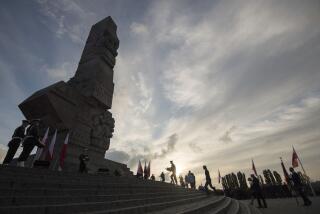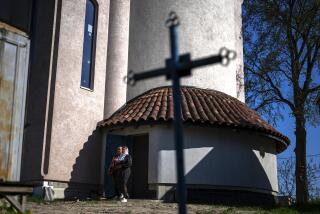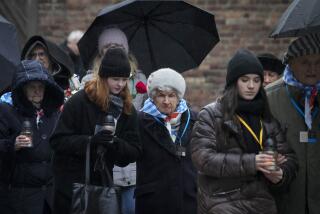Tableaus Revile Authorities, Draw Religious Parallels : Poles Update Their Easter Traditions, Adding Protest
WARSAW â Roman Catholic Poland on Saturday prepared for its Easter holiday with the traditional blessing of eggs and cake, symbols of todayâs feast marking the end of Lent.
But thousands of Poles stood for hours in the warm spring sun to observe a new Easter custom in some of Warsawâs largest churches, where the traditional tableaus of Jesusâ grave have been made over into powerful symbols of political protest.
All day long, people of all ages filed past these evocative scenes to pray and reflect on the deep division in their country between a Roman Catholic people and a Communist government.
âNew Traditionâ
âIt is a new tradition that began after martial law in 1981,â an activist in the outlawed Solidarity union explained outside the Jesuit church in Warsawâs Old Town area.
âAt first the theme was martial law, then last year it was political prisoners. This year, of course, it is Father Popieluszko.â
Father Jerzy Popieluszko was the charismatic 37-year-old Warsaw priest who served as Solidarityâs unofficial chaplain until his murder last October by officers of the security service. Four officers were convicted of the crime in February and sentenced to a total of 79 years in prison.
Despite strenuous government efforts to deflect suspicions that responsibility for his death went beyond the four officers, public bitterness persists, and church-state relations have soured amid attacks by the official press on the political activities of many churches.
The young priest is now widely accepted as a martyr to Polandâs struggle for democratic freedoms, and many hold him the equal of Father Maximilian Kolbe, the Polish cleric who volunteered for execution at the Auschwitz death camp in 1941 to save another manâs life. Kolbe was canonized in 1982.
Big Crowds at Churches
At least four major churches in Warsaw drew large crowds Saturday as they unveiled tableaus portraying Popieluszkoâs killing. The scenes ranged from the poignant to the boldly defiant.
At the slain priestâs church, St. Stanislaw Kostka in the Zoliborz district, a broad line two blocks long waited to file past the priestâs flower-decked grave in the churchyard, past a profusion of Solidarity banners, then inside.
An alcove of the church had been turned into a small grove of birch trees with leaves and flowers on the ground, representing one of the wooded sites where Popieluszko was kidnaped and beaten before being thrown into a reservoir. Here, as in other churches, the traditional figure of Jesus was replaced by a make-believe body trussed in a sack.
A tableau at St. Anneâs Church in Warsaw symbolically equated Father Popieluszkoâs death with Maximilian Kolbeâs. The blue-and-white-striped uniform of an Auschwitz inmate, laid out on a stretcher amid gruesome iron tongs used for pulling bodies into the crematoriums, represented Kolbeâs death. Next to it lay a black coffin draped with a priestâs cassock. A sign read, âChristâs and Their Deaths Are Our Hope.â
The longest lines in Warsaw on Saturday wound for blocks across the cityâs historic Castle Square and through the Old Town to the 17th-Century Jesuit church, which displayed the boldest and most suggestive scene of Popieluszkoâs death.
A tall, white cross was laced with ropes which ended at what appeared to be a burlap sack of stones, like the one his killers lashed to his feet before throwing him into a Vistula River reservoir. The sack, and a second sack with a life-sized figure inside, lay on sheets of watery blue plastic arranged like waves.
Protest Becomes Commerce
Zwyciezy!-- He Conquered--was written in bold red letters on the cross. The word zlo-- evil--hung on three towering steel bars (for three killers) painted in the blue-gray color of Polish police uniforms. A stand outside the church was doing a lively business selling color photographs of the scene.
The Easter scenes were not the only signs of protest. Polandâs robust underground press has turned out political Easter cards with stunning graphic designs. One is a block print of a hand thrust high, fingers spread in a V-for-victory and a crucifix between them.
Another, more whimsical card features an Easter egg decorated with the word Solidarity in the process of hatching. Thrusting through the shell in place of a chicken is a hand forming the familiar victory sign.
More to Read
Sign up for Essential California
The most important California stories and recommendations in your inbox every morning.
You may occasionally receive promotional content from the Los Angeles Times.










